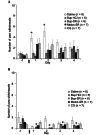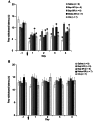Postoperative Analgesia Due to Sustained-Release Buprenorphine, Sustained-Release Meloxicam, and Carprofen Gel in a Model of Incisional Pain in Rats (Rattus norvegicus)
- PMID: 27177563
- PMCID: PMC4865691
Postoperative Analgesia Due to Sustained-Release Buprenorphine, Sustained-Release Meloxicam, and Carprofen Gel in a Model of Incisional Pain in Rats (Rattus norvegicus)
Abstract
Postoperative analgesia in laboratory rats is complicated by the frequent handling associated with common analgesic dosing requirements. Here, we evaluated sustained-release buprenorphine (Bup-SR), sustained-release meloxicam (Melox-SR), and carprofen gel (CG) as refinements for postoperative analgesia. The aim of this study was to investigate whether postoperative administration of Bup-SR, Melox-SR, or CG effectively controls behavioral mechanical and thermal hypersensitivity in a rat model of incisional pain. Rats were randomly assigned to 1 of 5 treatment groups: saline, 1 mL/kg SC BID; buprenorphine HCl (Bup HCl), 0.05 mg/kg SC BID; Bup-SR, 1.2 mg/kg SC once; Melox-SR, 4 mg/kg SC once; and CG, 2 oz PO daily. Mechanical and thermal hypersensitivity were tested daily from day-1 through 4. Bup HCl and Bup-SR attenuated mechanical and thermal hypersensitivity on days 1 through 4. Melox-SR and CG attenuated mechanical hypersensitivity-but not thermal hypersensitivity-on days 1 through 4. Plasma concentrations, measured by using UPLC with mass spectrometry, were consistent between both buprenorphine formulations. Gross pathologic examination revealed no signs of toxicity in any group. These findings suggest that postoperative administration of Bup HCl and Bup-SR-but not Melox-SR or CG-effectively attenuates mechanical and thermal hypersensitivity in a rat model of incisional pain.
Figures






Similar articles
-
Use of Liposomal Bupivacaine for Postoperative Analgesia in an Incisional Pain Model in Rats (Rattus norvegicus).J Am Assoc Lab Anim Sci. 2017 Jan 1;56(1):63-68. J Am Assoc Lab Anim Sci. 2017. PMID: 28905717 Free PMC article.
-
Sustained release buprenorphine effectively attenuates postoperative hypersensitivity in an incisional pain model in neonatal rats (Rattus norvegicus).PLoS One. 2021 Feb 3;16(2):e0246213. doi: 10.1371/journal.pone.0246213. eCollection 2021. PLoS One. 2021. PMID: 33534864 Free PMC article.
-
Antinociceptive effects of sustained-release buprenorphine in a model of incisional pain in rats (Rattus norvegicus).J Am Assoc Lab Anim Sci. 2014 Mar;53(2):193-7. J Am Assoc Lab Anim Sci. 2014. PMID: 24602547 Free PMC article.
-
Pharmacokinetics of sustained-release analgesics in mice.J Am Assoc Lab Anim Sci. 2014 Sep;53(5):478-84. J Am Assoc Lab Anim Sci. 2014. PMID: 25255070 Free PMC article.
-
Safety and efficacy of buprenorphine for analgesia in laboratory mice and rats.Lab Anim (NY). 2012 Nov;41(11):337-43. doi: 10.1038/laban.152. Lab Anim (NY). 2012. PMID: 23079917 Review.
Cited by
-
Use of Liposomal Bupivacaine for Postoperative Analgesia in an Incisional Pain Model in Rats (Rattus norvegicus).J Am Assoc Lab Anim Sci. 2017 Jan 1;56(1):63-68. J Am Assoc Lab Anim Sci. 2017. PMID: 28905717 Free PMC article.
-
Sustained release buprenorphine effectively attenuates postoperative hypersensitivity in an incisional pain model in neonatal rats (Rattus norvegicus).PLoS One. 2021 Feb 3;16(2):e0246213. doi: 10.1371/journal.pone.0246213. eCollection 2021. PLoS One. 2021. PMID: 33534864 Free PMC article.
-
A novel excisional wound pain model for evaluation of analgesics in rats.Korean J Pain. 2021 Apr 1;34(2):165-175. doi: 10.3344/kjp.2021.34.2.165. Korean J Pain. 2021. PMID: 33785668 Free PMC article.
-
Clinical Management of Pain in Rodents.Comp Med. 2019 Dec 1;69(6):468-489. doi: 10.30802/AALAS-CM-19-000048. Epub 2019 Dec 10. Comp Med. 2019. PMID: 31822323 Free PMC article. Review.
-
Lipid bound extended release buprenorphine (high and low doses) and sustained release buprenorphine effectively attenuate post-operative hypersensitivity in an incisional pain model in mice (Mus musculus).Animal Model Exp Med. 2021 Mar 23;4(2):129-137. doi: 10.1002/ame2.12157. eCollection 2021 Jun. Animal Model Exp Med. 2021. PMID: 34179720 Free PMC article.
References
-
- Balcombe JP, Barnard ND, Sandusky C. 2004. Laboratory routines cause animal stress. Contemp Top Lab Anim Sci 43:42–51. - PubMed
-
- Bauer DJ, Christenson TJ, Clark KR, Powell SK, Swain RA. 2003. Acetaminophen as a postsurgical analgesic in rats: a practical solution to neophobia. Contemp Top Lab Anim Sci 42:20–25. - PubMed
-
- Brennan TJ, Vandermeulen EP, Gebhart GF. 1996. Characterization of a rat model of incisional pain. Pain 64:493–501. - PubMed
Publication types
MeSH terms
Substances
Grants and funding
LinkOut - more resources
Full Text Sources
Research Materials
